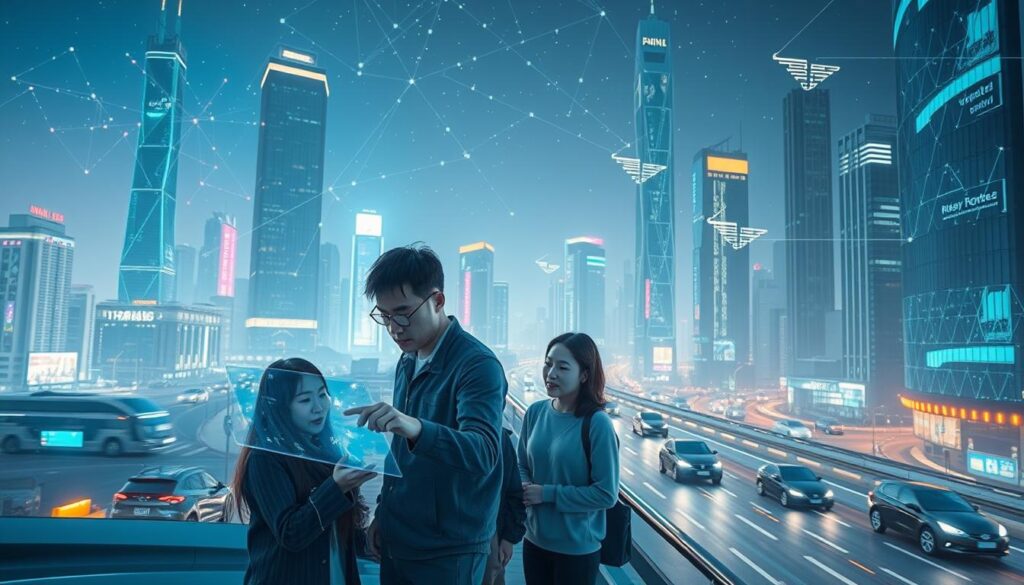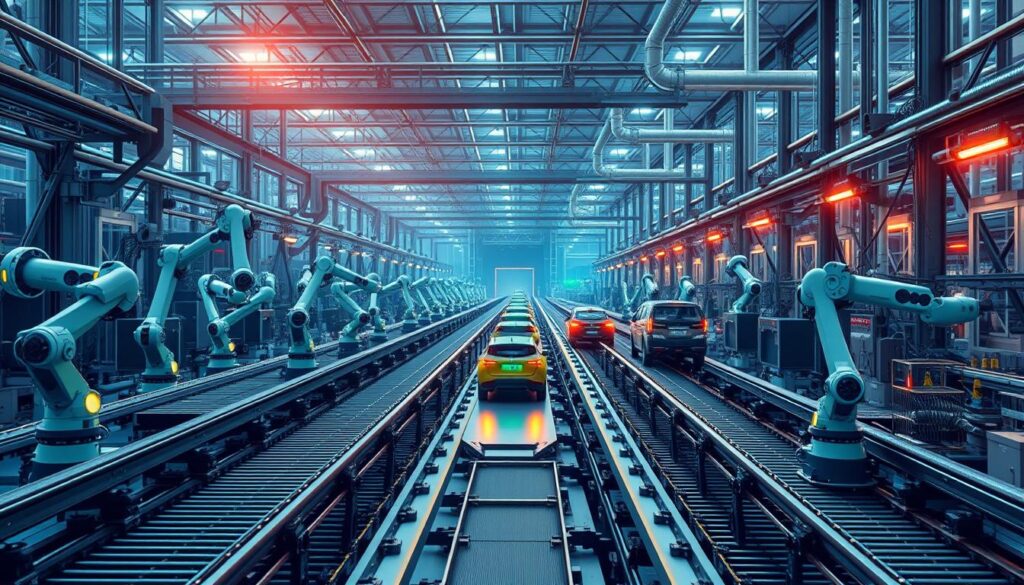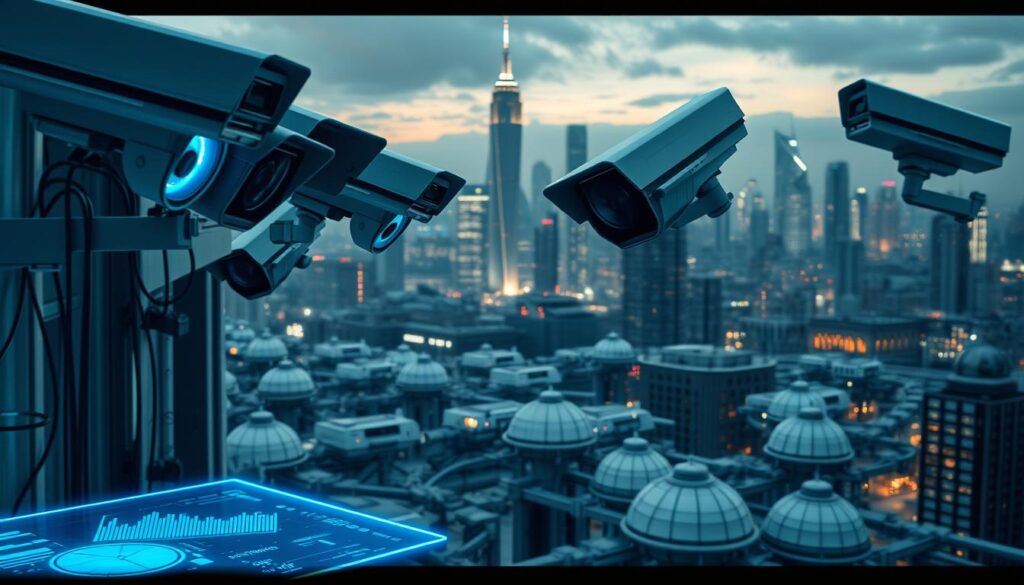As Albert Einstein once said, “The measure of intelligence is the ability to change.” This rings true in the realm of artificial intelligence, where innovation and adaptability are key. In July 2024, experts from the Atlantic Council Global China Hub and the Special Competitive Studies Project gathered to discuss Beijing’s approach to AI development and deployment amidst US-China competition1.
China’s vision for technological self-reliance is driven by ambitious policies and significant milestones. With over 180 large language models approved for general use as of August 2024, the country is making strides in AI innovation1. Leaders like Xi Jinping have outlined a strategic roadmap, emphasizing national competitiveness and economic growth through advancements in technology1.
Government initiatives and industrial investments are laying the foundation for these advancements. For instance, Beijing announced a 10% increase in national research and development spending in March 2024, aiming to position China as a global leader in science and technology by 20351. Despite challenges, such as export controls on advanced semiconductors, China is leveraging domestically designed AI chips like Huawei’s Ascend 910B to bridge performance gaps1.
Key Takeaways
- China’s AI development focuses on technological self-reliance and economic growth.
- Over 180 large language models have been approved for general use as of August 2024.
- Government initiatives, including increased R&D spending, support AI advancements.
- Domestically designed AI chips are addressing performance challenges.
- Experts highlight both progress and hurdles in global AI competition.
Introduction and Overview

China’s approach to technological advancement is driven by a clear focus on innovation, research, and practical application. This strategy aims to position the country as a global leader in cutting-edge technologies. Recent discussions from the Atlantic Council and SCSP workshop highlight both the progress and challenges in this journey2.
At the core of this strategy is a robust policy framework. Government initiatives, such as increased R&D spending and subsidies for domestic AI chip purchases, are fueling industrial scalability2. These efforts are complemented by a growing ecosystem of start-ups and large-scale projects, like the “Eastern Data, Western Computing” initiative3.
Understanding key terms is essential. Innovation refers to the development of new technologies, while application focuses on their practical use. Research forms the backbone, driving discoveries that shape the future. Together, these elements create a dynamic environment for technological growth.
China’s technological evolution is influenced by both domestic and international factors. For instance, U.S. sanctions have pushed local firms to innovate independently, leading to advancements in domestically designed AI chips2. This dual influence shapes the country’s approach to global competition.
Looking ahead, China’s strategy emphasizes long-term goals. By 2035, the country aims to become a global leader in science and technology. This vision is supported by significant investments in infrastructure and talent development2.
| Metric | China | United States |
|---|---|---|
| AI Companies | 1,944 | 9,500 |
| Incoming Investments | 8,194 | 59,534 |
| Total Investment Value | $85.65 billion | $605.42 billion |
For more insights into global strategies, explore how innovation is shaping industries worldwide.
Evolution of China’s AI Landscape

The journey of technological evolution in China has been marked by significant milestones and strategic investments. From early policy frameworks to current multi-billion dollar initiatives, the country has consistently pushed the boundaries of innovation.
Policy Milestones and Government Initiatives
In 2017, the State Council approved the New Generation Artificial Intelligence Development Plan, setting ambitious goals to catch up with leading nations by 2020 and become a global leader by 20304. This plan laid the foundation for rapid advancements in the industry.
More than 40 policy and regulatory initiatives have been introduced since 2017, focusing on self-reliance and technological sovereignty5. These efforts have shaped the trajectory of AI development, emphasizing both economic growth and national security.
Historical Advancements and Trends
Historical trends reveal a rapid adoption of AI technologies across various sectors. The Artificial Intelligence + initiative promotes the integration of digital technologies into manufacturing and market processes4.
Export controls have spurred domestic innovation, with Chinese firms stockpiling GPUs and acquiring them through third-party countries5. This strategic positioning has propelled advancements in intelligence research and application.
For more insights into the AI Industry Development Action Plan, explore how these initiatives are shaping the future of technology.
China’s AI Strategy: The Future is Here!

Innovation and self-reliance define China’s approach to technological growth. President Xi Jinping has emphasized the importance of becoming a global leader in science and technology by 2035. This vision is supported by state-led reforms and significant investments in research and development1.
The government’s strategy focuses on bridging gaps in chip innovation and achieving superior artificial intelligence models. With over 4,500 firms developing and selling AI technologies, China is fostering a competitive ecosystem6. This ambition is further fueled by a 10 trillion yuan investment plan over the next 15 years6.
State-Led Reforms and Progress
State support plays a pivotal role in driving technological advancements. In March 2024, Beijing announced a 10% increase in national R&D spending, aiming to enhance industrial scalability1. This commitment underscores the government’s focus on long-term global leadership.
President Xi Jinping stated,
“We must ensure that artificial intelligence remains under human control while driving economic growth and national security.”
This principle is central to China’s approach, as highlighted in the Global AI Governance Initiative7.
Key Objectives in National Innovation
China’s objectives include achieving technological sovereignty and reducing dependency on foreign chip technologies. Domestically designed AI chips, like Huawei’s Ascend 910B, are addressing performance challenges7. These efforts are critical in the face of U.S. export controls on advanced semiconductors1.
International comparisons reveal China’s determination to lead. With over 180 large language models approved for general use, the country is narrowing the gap with global leaders1. For more insights into global strategies, explore how innovation is shaping industries worldwide.
China’s vision for the world stage is clear. By leveraging state support and strategic planning, the country is steering its industries toward long-term global leadership. This ambition is reshaping the technological landscape and setting new benchmarks for innovation.
Strategic Priorities Driving China’s AI Development

The rapid integration of advanced technologies is reshaping industries globally. In this context, industrial applications are playing a pivotal role in boosting productivity and economic growth. Manufacturing, in particular, has seen significant improvements through the adoption of innovative solutions8.
Industrial Applications and Economic Impact
Advanced models are transforming traditional sectors, leading to increased efficiency and profitability. For instance, the integration of intelligent systems in manufacturing has reduced operational costs by up to 20%9. This shift is also creating new opportunities in emerging markets, fostering economic diversification.
Companies like Narwal Robotics have expanded their global presence, reaching over 40 countries and serving 3 million users8. Such success stories highlight the economic potential of technological advancements in the market.
Research and Innovation Ecosystems
Robust research ecosystems are driving breakthroughs in technology. Government and private sector collaborations are essential in this process. For example, DeepSeek’s latest model demonstrates China’s ability to produce cutting-edge solutions at a lower cost10.
These innovations are also enhancing security protocols, ensuring safer and more reliable systems. The AI Safety Governance Framework (2024) provides guidelines for developers, emphasizing risk classification and safety measures10.
| Metric | Impact |
|---|---|
| Productivity Growth | Up to 20% |
| Global Market Reach | 40+ Countries |
| User Base | 3 Million |
For more insights into how these advancements are shaping industries, explore AI in finance.
AI Ecosystems: Fostering Innovation and Industry Growth

Innovation thrives in environments where collaboration meets structured control. In China, ecosystems are designed to nurture breakthroughs in computing and industrial capability. These systems rely on state-directed initiatives that create a controlled environment for systematic advancements11.
Government, academic institutions, and tech companies work together to boost technological capability. For example, Baidu’s ERNIE Bot has over 26,000 enterprise users, including Samsung China and Lenovo11. This collaboration drives progress and ensures practical applications of research.
External factors, like U.S. export controls on GPUs, challenge these ecosystems. However, they also encourage domestic advancements. Huawei’s Ascend 9XX series now outperforms some Nvidia GPUs on benchmarks11. This shift highlights the resilience of local innovation.
State support is critical in fostering innovation environments. The Cyberspace Administration of China has approved over 40 large language models in the past six months11. These approvals strengthen control over crucial technology sectors, ensuring long-term growth.
By integrating government, academia, and industry, China is building a robust ecosystem. This approach not only addresses immediate challenges but also sets the stage for global leadership in computing and technology12.
Funding, Investment, and Market Dynamics in Chinese AI

The financial landscape of China’s AI sector is evolving rapidly, driven by both challenges and opportunities. Venture capital plays a pivotal role, but resource allocation remains a critical factor in maintaining global competitiveness. Amid economic slowdowns, securing advanced computing resources like GPUs and chips has become a significant hurdle13.
Funding strategies are heavily influenced by policy decisions. For instance, state-backed financial support has increased to bridge gaps in processing power and technological advancements14. However, private investments are equally vital, creating a balanced ecosystem that fosters innovation.
Venture Capital and Resource Allocation
Venture capital funding in China’s AI sector has seen fluctuations due to global economic pressures. Despite this, smaller firms like DeepSeek are challenging larger incumbents, reshaping the tech ecosystem13. This shift highlights the importance of agile and cost-effective solutions in maintaining a competitive edge.
Resource allocation directly impacts processing capabilities. U.S. export controls on advanced chips have pushed local firms to innovate independently, leading to breakthroughs in domestically designed hardware13. This resilience underscores the sector’s adaptability.
| Funding Source | Impact |
|---|---|
| State-Backed Support | Bridges gaps in processing power |
| Private Investments | Drives innovation and agility |
| Venture Capital | Supports smaller, disruptive firms |
Policy decisions continue to shape funding dynamics. The government’s focus on technological sovereignty ensures long-term growth, while private investments bring flexibility and creativity to the table14. This dual approach is key to maintaining leadership in the global AI race.
Competitive Metrics: US vs. China in AI Development

The competition between the U.S. and China in technological advancements has become a defining feature of the global landscape. Recent benchmarks highlight the strengths and weaknesses of both nations, particularly in areas like processing power and innovation ecosystems15.
Performance Benchmarks and Model Assessments
Recent comparisons reveal that Chinese models, such as DeepSeek-R1, rival U.S. counterparts like OpenAI’s offerings in performance while operating on a lower compute budget15. This efficiency demonstrates China’s growing capability in developing cost-effective solutions.
However, the U.S. retains leadership in certain areas, particularly in advanced reasoning models and overall processing speeds. For example, Nvidia’s H20 chip, introduced after 2023 export controls, remains the best option accessible to China for running complex models15.
Competitive Advantages and Shortfalls
China’s innovation ecosystem has shown remarkable resilience, especially in the face of U.S. export controls. Domestically designed chips, like Huawei’s Ascend series, are bridging performance gaps15. Yet, access to advanced computing resources remains a challenge, limiting scalability.
On the other hand, the U.S. benefits from a robust research environment and significant venture capital investments. In 2020, 82% of global funding went to U.S. and Chinese startups, with the U.S. leading at $27.6 billion16.
Key areas where China excels include cost efficiency and rapid deployment of technologies. However, systemic shortfalls, such as reliance on external resources, highlight the need for further development in its innovation ecosystem15.
Looking ahead, both nations are poised to shape the future of technology. The U.S. aims to maintain its lead, while China focuses on achieving technological sovereignty and reducing dependency on foreign resources16.
Overcoming Technical Challenges: AI Hardware and Compute Constraints

Technical challenges in hardware and computing are shaping the global race for innovation. For many companies, access to advanced chips and efficient processing power remains a critical hurdle. These constraints are particularly evident in the face of international competition and restrictive policies17.
US Export Controls and Advanced Chip Restrictions
US export controls have significantly impacted the availability of advanced chips, limiting their use in large-scale model development17. These restrictions aim to reduce the scale and efficiency of training processes, creating challenges for companies reliant on cutting-edge technology. Despite these barriers, firms have adapted by stockpiling GPUs and exploring alternative solutions17.
For example, DeepSeek accumulated tens of thousands of Nvidia GPUs before the restrictions took effect, ensuring continued progress in their projects17. This strategic move highlights the resilience of companies in navigating complex regulatory environments.
Domestic Innovations in Semiconductor Production
In response to these challenges, domestic efforts to innovate in semiconductor production have intensified. Companies like Huawei have developed alternatives such as the Ascend series, which bridge performance gaps caused by restricted access to foreign chips17.
These advancements demonstrate the nation’s commitment to achieving technological sovereignty. By focusing on cost-effective solutions, Chinese firms are narrowing the timeline differences in chip development compared to global competitors17.
For instance, DeepSeek’s V3 base model was developed in just two months with a budget of under $6 million, showcasing the efficiency of domestic innovation17. Such achievements underscore the potential for progress despite ongoing competition.
As the global landscape evolves, these efforts are reshaping the dynamics of technological leadership. By addressing hardware and compute constraints, companies are paving the way for sustained innovation and growth18.
The Impact of Regulations and Censorship on AI Innovation

Regulations and censorship play a dual role in shaping technological progress. While they ensure safety and alignment with societal values, they can also hinder the pace of innovation. This tension is particularly evident in the tech sector, where ambitious startups often face stringent oversight.
In late 2021, the world’s first comprehensive regulation for algorithm-powered recommendation systems was introduced, setting a precedent for controlled innovation19. By early 2023, measures to curb deepfake production further tightened the regulatory environment19. These steps highlight the government’s approach to balancing innovation with security.
Regulatory Environment and Safety Oversight
Safety oversight schemes are designed to ensure secure applications, but they can inadvertently slow progress. For instance, in 2023, Chinese authorities prohibited major platforms like Tencent and Ant Group from integrating ChatGPT, citing compliance concerns19. Such restrictions create challenges for startups aiming to push boundaries.
Experts argue that while regulations are necessary, they must evolve to support rather than stifle creativity.
“Innovation thrives in environments where risks are managed, not eliminated,”
says a leading tech analyst. This perspective underscores the need for a balancedapproachto oversight.
Fostering Startups Amidst Regulations
The tension between fostering ambitious startups and adhering to strict regulations is a recurring theme. Between 2020 and 2022, a sweeping crackdown on tech firms highlighted the challenges of navigating this landscape19. Yet, government initiatives, such as the introduction of ten AI-related policies between 2015 and 2018, also demonstrate support for innovation19.
For example, DeepSeek’s models, trained on Nvidia chips acquired under U.S. export controls, showcase how startups adapt to regulatory constraints20. Such adaptability is crucial for maintaining momentum in a competitive market.
Proposals for Regulatory Adjustments
To address these challenges, experts propose adjustments that balance innovation with safety. For instance, aligning large language models with “core values of socialism” ensures compliance while allowing room for creativity20. This approach could help startups thrive without compromising security.
Ultimately, the goal is to create a regulatory framework that supports both innovation and societal well-being. By fostering collaboration between policymakers and tech leaders, it’s possible to achieve this balance and drive sustainable progress.
Industrial Revolution: AI Advancements in Manufacturing

The integration of advanced technologies is transforming manufacturing processes worldwide. Smart automation and efficiency improvements are reshaping traditional industries, creating a new era of productivity. These advancements are not just about speed but also about precision and sustainability.
In recent years, the adoption of intelligent systems has led to significant cost reductions and operational improvements. For example, integrating AI into industrial processes has cut operational costs by up to 20%21. This shift is driving economic growth and fostering innovation across sectors.
China has emerged as a leader in this transformation, deploying nearly 300,000 industrial robots compared to 40,000 in the United States1. This disparity highlights the contrasting scales of automation adoption between the two nations. While the United States focuses on advanced reasoning models, China prioritizes cost-effective solutions and rapid deployment.
A series of government initiatives has accelerated these advancements. For instance, Beijing’s increased R&D spending has fueled industrial scalability and technological innovation1. These efforts are part of a broader strategy to achieve global leadership in manufacturing technology.
The system integration of AI into manufacturing processes is creating sustainable productivity gains. Companies are leveraging intelligent systems to optimize supply chains, reduce waste, and enhance product quality. This approach is not only improving efficiency but also reducing environmental impact.
For more insights into how these advancements are shaping industries, explore how innovation is driving robotics and.
Robotics and Intelligent Automation in China’s Strategy

Robotics and intelligent automation are reshaping industries, driven by strategic investments and demographic shifts. The government has played a pivotal role in steering research and development, ensuring that both industrial and humanoid robots are integrated into the economy22.
China’s dual strategy focuses on deploying robots across various sectors. Industrial robots are transforming manufacturing, while humanoid robots are being developed to address labor shortages in public services23. This approach is supported by significant funding and policy initiatives, creating a robust ecosystem for innovation.
Industrial and Humanoid Robots
Industrial robots have become a cornerstone of China’s manufacturing sector. In 2022, the country installed over 243,300 industrial robots, representing more than 50% of the global total23. These robots are enhancing productivity and reducing operational costs, making China a leader in industrial automation.
Humanoid robots, on the other hand, are gaining traction due to demographic challenges. By 2050, China’s working-age population is projected to decrease by over 20%, creating a pressing need for automation in sectors like healthcare and construction23. The government is actively promoting the development of humanoid robots, with initiatives like the Humanoid Robot Training Base in Shanghai24.
“The integration of robotics into our economy is not just about efficiency; it’s about addressing the challenges of an aging population,”
said a spokesperson from the Ministry of Industry and Information Technology.
Advancements in science and technology are driving these innovations. Domestic firms are producing cost-effective alternatives to Western machines, with prices as low as 20% of their competitors22. This has enabled rapid deployment and scalability, positioning China as a global leader in robotics.
| Metric | China | Global Comparison |
|---|---|---|
| Industrial Robots Installed (2022) | 243,300 | 50% of Global Total |
| Humanoid Robot Market Growth (2022-2023) | 86% | Global Leader |
| Robot Density (2024) | 470 units per 10,000 employees | Target: 500 by 2025 |
For more insights into how robotics is transforming industries, explore AI and robotics advancements.
Biotechnology Integration: AI in Healthcare and Beyond

Biotechnology is transforming healthcare, with advanced tools reshaping diagnostics and treatment. The integration of intelligent systems into medical research is driving breakthroughs in precision medicine and synthetic biology. This fusion of disciplines is creating new opportunities for innovation and efficiency.
Applications in Medical Innovation
Intelligent algorithms are revolutionizing diagnostics, reducing false positives and negatives in breast cancer detection. For diabetes management, machine learning models achieve up to 97.8% accuracy in predicting complications25. These advancements are improving patient outcomes and reducing healthcare costs.
In cardiology, predictive models like Fuzzy-GBDT are enhancing heart disease diagnosis with exceptional accuracy25. Neuroimaging studies also benefit, with deep learning identifying subtle changes in conditions like Alzheimer’s25. These tools are making healthcare more precise and accessible.
Synthetic Biology and Advanced Research
Synthetic biology is leveraging computational power to design new biological systems. This field is advancing drug development and personalized medicine. For example, AI-powered platforms are accelerating the discovery of novel therapies, reducing development timelines26.
Government policy is crucial in fostering these innovations. Initiatives like increased R&D funding and subsidies for domestic technologies are driving progress25. These efforts are creating a robust ecosystem for biotech advancements.
The nurturing of talent is equally important. Educational programs and research grants are attracting skilled professionals to the field. This focus on human capital is ensuring sustained growth and innovation in biotechnology.
| Metric | Impact |
|---|---|
| Diabetes Prediction Accuracy | 97.8% |
| Heart Disease Diagnosis Accuracy | 98.5% |
| Neuroimaging Diagnostic Progress | Significant |
Technology transfer between manufacturing and bioengineering is also driving innovation. For instance, automation techniques from industrial processes are being adapted for lab workflows, increasing efficiency26. This cross-disciplinary approach is accelerating breakthroughs in biotechnology.
National Security Implications of China’s AI Ambitions

The intersection of technology and national security is reshaping global dynamics. In this context, the country has prioritized integrating advanced systems into its defense and security frameworks. This approach aims to enhance both internal stability and global competitiveness27.
Military Applications and Autonomous Systems
Autonomous systems are playing a pivotal role in modern defense strategies. The country has developed advanced technologies for military command structures, enabling faster decision-making and improved operational efficiency28. These systems are part of a broader plan to secure critical areas of national infrastructure.
For instance, the integration of intelligent algorithms into surveillance drones has enhanced border security. This innovation allows for real-time monitoring and rapid response to potential threats27. Such advancements underscore the country‘s commitment to leveraging technology for national security.
Surveillance and Data-Driven Security
Data-driven techniques are transforming internal security apparatuses. The country has implemented advanced surveillance systems that utilize machine learning to analyze vast amounts of data. This approach helps identify potential risks and ensures proactive measures28.
These systems are part of a comprehensive plan to maintain control over critical areas. For example, facial recognition technology is widely used in urban centers to monitor public spaces and ensure safety27. This integration of technology into security frameworks highlights the country‘s focus on innovation.
“The fusion of technology and security is not just about efficiency; it’s about creating a safer and more stable environment,”
These initiatives have significant geopolitical ramifications. By linking technological advancements with state-level security interests, the country is positioning itself as a global leader in both innovation and defense28. This strategy underscores the importance of technology in shaping the future of national security.
Geopolitical Tensions and the Global AI Arms Race
The geopolitical landscape is increasingly shaped by the race for technological dominance. This competition is most evident between the United States and China, where both nations vie for control over critical resources like advanced software, hardware, and computational capacity29. This rivalry is not just about innovation but also about securing a strategic edge in global technology trends.
US-China Tech Competition
The U.S. and China are locked in a high-stakes battle over technological supremacy. Recent export controls imposed by the U.S. Commerce Department have significantly impacted China’s access to advanced semiconductors, a critical resource for AI development30. These restrictions aim to limit China’s ability to scale its AI capabilities, creating a significant challenge for its tech industry.
Despite these hurdles, China has made strides in developing domestic alternatives. For instance, Huawei’s Ascend series has bridged some performance gaps caused by restricted access to foreign chips29. This resilience underscores the strategic importance of self-reliance in the face of geopolitical tensions.
International Security and Economic Risks
The competition over AI technologies extends beyond national borders, posing risks to global security and economic stability. The U.S. allocated approximately $717 billion for defense in 2024, with significant portions directed toward AI-driven technologies31. Similarly, China’s military expenditure on AI is estimated to be in the low billions, reflecting its commitment to integrating AI into national defense strategies31.
This arms race has broader implications. Nations are increasingly compelled to align with either the U.S. or China, leading to the fragmentation of the global AI ecosystem31. Such polarization could exacerbate economic vulnerabilities and heighten the risk of miscalculation in international relations.
| Metric | United States | China |
|---|---|---|
| Defense Spending (2024) | $717 billion | Low billions |
| AI Military Integration | Advanced AI-driven systems | Focus on autonomous systems |
| Export Controls | Restrictions on advanced semiconductors | Development of domestic alternatives |
The long-term implications of this competition are profound. As both nations invest heavily in AI, the global balance of power is being reshaped. This dynamic not only influences technological innovation but also poses significant risks to international security and economic stability31.
Strategic Research and Future Technology Priorities
Breaking new ground in technology requires a focus on fundamental research and infrastructure. Government-backed initiatives are driving this effort, with significant investments aimed at achieving long-term breakthroughs. For example, Alibaba announced a $52 billion investment in cloud and advanced technologies over the next three years, signaling a strong commitment to innovation32.
Fundamental Research and Talent Development
Nurturing talent is essential for sustaining innovation. The State Council’s 2017 plan aims to position the country as a global leader by 2030, emphasizing the importance of education and research32. Programs focused on STEM fields are attracting skilled professionals, ensuring a steady pipeline of expertise.
Addressing risk is also critical. Diversifying investments and pooling resources help mitigate uncertainties in research outcomes1. This approach ensures that groundbreaking discoveries are not hindered by financial or operational challenges.
Collaboration and Global Partnerships
Global partnerships are accelerating progress. Collaborative projects bring together expertise from different regions, fostering innovation on a larger scale. For example, joint ventures between domestic firms and international organizations are yielding significant advancements in key technologies33.
These partnerships also address risk by sharing knowledge and resources. By working together, nations can overcome barriers and achieve shared goals in technological development.
Investments in infrastructure are equally important. Building state-of-the-art research facilities and expanding computational capabilities are essential for supporting large-scale projects. For example, Beijing’s 10% increase in R&D spending highlights the growing priority of fundamental research1.
Understanding China’s AI strategy provides deeper insights into how these efforts are shaping the global landscape. By focusing on research, talent, and collaboration, the country is positioning itself as a leader in technological innovation.
Conclusion
Technological advancements are reshaping global dynamics, with strategic priorities influencing industries, security, and research. The evolution of policies, innovation, and market dynamics highlights the interconnected nature of these domains. Understanding the full value of these advancements is crucial for reshaping industries and ensuring national security.
Key fields of research, such as fundamental technology and talent development, are driving progress. These efforts are supported by significant investments, like Beijing’s 10% increase in national R&D spending1. Such initiatives underscore the importance of innovation in maintaining global competitiveness.
Looking ahead, these strategic priorities will continue to influence both domestic and international stakeholders. The U.S. and other nations must adapt to this evolving landscape, balancing competition with collaboration. The potential impact of these advancements will shape the future of technology and global leadership.
FAQ
What are the key objectives of China’s AI strategy?
How does China’s AI ecosystem foster innovation?
What role does the government play in China’s AI development?
How does China address challenges in AI hardware and computing?
What are the national security implications of China’s AI ambitions?
How does China’s AI strategy impact global competition?
What industries benefit most from China’s AI advancements?
How does China ensure talent development in AI?
Source Links
- Assessing China’s AI development and forecasting its future tech priorities
- How Innovative Is China in AI?
- China’s AI development model in an era of technological deglobalization
- China’s AI revolution: How Beijing reshapes the global tech landscape | News.az
- DeepSeek Is Reshaping China’s AI Landscape
- From chatbots to intelligent toys: How AI is booming in China
- China’s Views on AI Safety Are Changing—Quickly
- China’s AI Boom: Talent and Innovation Driving the Future – RisCura
- China’s AI future in a quest for geopolitical, computing and electric power
- China’s Generative AI Ecosystem in 2024: Rising Investment and Expectations
- Exploring China’s Leading AI Hubs: A Regional Analysis
- The smart money is headed for China’s AI boom – Asia Times
- Baidu, once China’s generative AI leader, is battling to regain its position
- What DeepSeek Revealed About the Future of U.S.-China Competition
- China and the U.S. produce more impactful AI research when collaborating together – Scientific Reports
- China’s DeepSeek and its Open-Source AI Models
- Horizon Robotics and the Rise of Chinese AVs / Real World AI (Tech Strategy – Podcast 240) – Jeffrey Towson 陶迅
- The Real Threat of Chinese AI
- China And AI In 2025: What Global Executives Must Know To Stay Ahead
- China’s Robots Are Coming of Age
- China’s Leap into Robotics for Industry
- China’s AI and Robotics Landscape: A New Era
- The Role of AI in Hospitals and Clinics: Transforming Healthcare in the 21st Century
- AI is Rewriting the Rules of Healthcare: A 2025 Investor’s Playbook
- The American Playbook to Win the AI Race With China – American Edge Project
- How Might the United States Engage with China on AI Security Without Diffusing Technology?
- The AI Superpower Rivalry: A Zero-sum Game Between China and the United States?
- ‘AI Cold War Is Here’: Are We Ready for the AI Race?
- AI Rivalries: Redefining Global Power Dynamics
- China’s AI Renaissance: How Xi’s Summit is Reshaping the Future of Tech
- Strategic Reorientation on AI Competition with China







